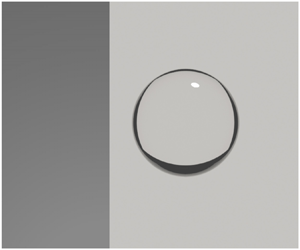Published online by Cambridge University Press: 04 June 2021

As two particles approach each other, the continuum lubrication force diverges, with decreasing separation preventing contact. However, for separations comparable to the mean free path of the gas,  $\lambda$, non-continuum effects cause the lubrication force to diverge more slowly with decreasing separation distance, allowing for contact in finite time. The first study of this phenomenon was done by Sundararajakumar & Koch (J. Fluid Mech., vol. 313, 1996, pp. 238–308) for two particles moving along their line of centres. We extend their normal motion study to include tangential motions. For small Knudsen number
$\lambda$, non-continuum effects cause the lubrication force to diverge more slowly with decreasing separation distance, allowing for contact in finite time. The first study of this phenomenon was done by Sundararajakumar & Koch (J. Fluid Mech., vol. 313, 1996, pp. 238–308) for two particles moving along their line of centres. We extend their normal motion study to include tangential motions. For small Knudsen number  $Kn=\lambda / a$, where
$Kn=\lambda / a$, where  $a$ is the harmonic mean of the two particle radii, we use a matched asymptotic expansion technique to obtain the non-continuum forces and torques for tangential motions of spheres separated by distances within the lubrication regime that are at or below the mean free path of the gas. The hydrodynamic resistivity functions are fitted to provide a uniformly valid approximation that smoothly transitions between the continuum multipole and non-continuum lubrication expressions for the forces and torques as the minimum gap between the particles
$a$ is the harmonic mean of the two particle radii, we use a matched asymptotic expansion technique to obtain the non-continuum forces and torques for tangential motions of spheres separated by distances within the lubrication regime that are at or below the mean free path of the gas. The hydrodynamic resistivity functions are fitted to provide a uniformly valid approximation that smoothly transitions between the continuum multipole and non-continuum lubrication expressions for the forces and torques as the minimum gap between the particles  $h_0$ varies from values of
$h_0$ varies from values of  $O(a)$ to values of
$O(a)$ to values of  $O(\lambda )$. These functions, in combination with the result by Sundararajakumar & Koch (J. Fluid Mech., vol. 313, 1996, pp. 238–308) and the classical work by Jeffrey & Onishi (J. Fluid Mech., vol. 139, 1984, pp. 261–290), yield a complete formulation for the hydrodynamic interactions of two spheres at all separations, from non-interacting spheres in the extreme far field through all the transitions that occur up to contact. We apply the new formulation to the classical case of a particle settling parallel to a vertical wall. The continuum Stokes equation predicts a settling speed that decreases with decreasing gap separation and vanishes at contact, whereas the non-continuum model developed herein predicts a finite settling speed at contact.
$O(\lambda )$. These functions, in combination with the result by Sundararajakumar & Koch (J. Fluid Mech., vol. 313, 1996, pp. 238–308) and the classical work by Jeffrey & Onishi (J. Fluid Mech., vol. 139, 1984, pp. 261–290), yield a complete formulation for the hydrodynamic interactions of two spheres at all separations, from non-interacting spheres in the extreme far field through all the transitions that occur up to contact. We apply the new formulation to the classical case of a particle settling parallel to a vertical wall. The continuum Stokes equation predicts a settling speed that decreases with decreasing gap separation and vanishes at contact, whereas the non-continuum model developed herein predicts a finite settling speed at contact.